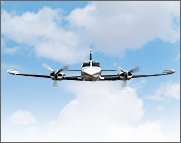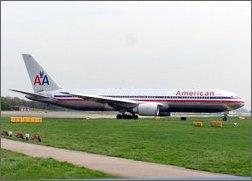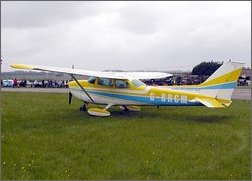The Risk of Flying in Small Airplanes vs. Large Airplanes
by www.SixWise.com
On January 30, 2006, a small Cessna 421B plane crashed a
mile from Palwaukee airport in Wheeling, Illinois, a suburb
of Chicago, killing all 4 aboard. This accident was one of
ten fatal crashes and 56 small aircraft accidents in the first
weeks of 2006 in the U.S.
|

85% of small plane accidents are due to pilot error,
while only 37% of large plane accidents are due to pilot
error.
|
And according to the FAA's August 2005 Factbook, there were
2,339 small aircraft accidents in 2004-2005 and only 39 accidents
involving large airliners.
With air traffic expected to double
in the next 20 years, and initiatives underway to source
this surge in air travel to smaller planes, it is worthwhile
to understand the basics behind why it is considerably more
risky to fly in small versus larger commercial airplanes.
(It also bears repeating that flying
in any sort of plane is still far less dangerous than driving
in a car.)
For starters, over 50% of the active aircraft in the U.S.
are considered small aircraft, and over 75% of the pilots
in the U.S. are licensed to fly only small aircraft. Many
fly without the aid of Air Traffic Control, and use small
airports with no control towers.
Visual Flight Rules (VFR) vs. Instrument Flight Rules
(IFR)
To become a small airplane pilot requires about 50-70 hours
of flight training, with various studies in meteorology, navigation,
simple aircraft maintenance, air law regulations, cockpit
practices and principles of flight.
All small aircraft pilots must also be minimally trained
using Visual Flight Rules. VFR training limits when and where
pilots can fly.
Visual Flight Rules (VFR) pilots must fly in good weather,
and are required to keep a specific distance from clouds with
a strict minimum visual requirement. The pilot visually controls
altitude, navigation and is responsible for maintaining safe
distances from other aircraft and obstacles (terrain).
Small aircraft pilots trained for VFR usually fly under 12,500
feet, in uncontrolled airspace. Additionally their cabins
are usually not pressurized and do not carry oxygen supplies.
They are able to choose their own course and heading, use
small airports with no control towers, and are not required
to communicate with Air Traffic Control (ATC). The pilot alone
is responsible.
Instrument Flight Rule (IFR) training combined with the necessary
instrumentation and the support of Air Traffic Control allows
continued flight operations in reduced or no visibility situations.
All major airline pilots are IFR trained.
|

Air Traffic Control operates airspace between 18,000
and 60,000 feet. All airspace from 18,000 - 60,000 feet
is designated Class A, requiring all aircraft to operate
under Instrument Flying Rules (IFR), relying wholly
on ATC.
|
IFR pilots are further trained to use on- board instrumentation
to fly, and must communicate with Air Traffic Control, when
operating above 18,000 feet. Instead of using only visuals,
ATC can support them in navigation through bad weather and
in separation from other aircraft and terrain.
Small Aircraft Transportation System
85% of all small plane accidents are
due to pilot error, generally the pilot's lack of good
judgment in knowing their limitations. Mechanical failures
play a role in only a small percentage of small plane fatalities
and are usually compounded by pilot error.
Pilot error accounts for only 37% of large airline accidents.
However, the major airports - home of the large airliners
-- are busier than ever, clogged with delays and security
issues.
In an effort to resolve these growing problems, the FAA and
NASA have embarked on an ambitious research project called
the "Small Aircraft Transportation System" (SATS).
Together the FAA and NASA are exploring ways to use small
aircraft to ease the strain of today's airline schedules.
The idea is to utilize the 3,400 small airports in the U.S.
to free up the scheduling problems and traffic of the major
airport hubs.
|

"The small aircraft transportation vision is a
safe travel alternative freeing people and products
from transportation system delays, by creating access
to more communities in less time." -The SATS Vision
|
But weather, poor safety records, and capacity at the smaller
airports, both in the air and on the ground, are key issues
requiring solutions for the SATS project.
Some of SATS research will include:
-
The ability of small aircraft pilots to function in
constantly evolving airspace, keeping up with technology,
training and advancements.
-
The high volume of airplanes at small airports with
no control towers
-
Finding better technology for safe landings in severe
weather
-
Integrating small planes with the higher capacity air
traffic control airspace
While flying in small airplanes is indeed more of a risk
than large commercial airliners, though, it pays to refresh
yourself on why a fear of flying is largely an irrational
one, at least relative to other dangers.
We encourage you to read Fear
of Flying: How to Get Over Your Phobia of Flying in an Airplane
for details on why, and strategies on how to overcome your
fears.
Recommended Reading
Fear
of Flying: How to Get Over Your Phobia of Flying in an Airplane
Sources
Latest
Safety Occurrences
Commercial
Airplanes
Plane
Didn't Call for Help Before Crashing
Federal Aviation
Administration
National Transportation
Safety Board
Latest
News
Small
Aircraft Transportation System
Fixed
Wing Aircraft
General
Aviation